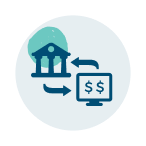Author Elaina Johannessen is program director for debt management plan operations with LSS Financial Counseling.
Living paycheck to paycheck doesn’t sound scary at first. It means that you’re able to cover all your monthly/ongoing expenses. Some people might think, “I’m doing just fine and making ends meet. So, what’s the big deal?” For those of us who have had emergency vet visits, a broken hot water heater, or a backed-up sewer (*raises hand*) we know that living paycheck to paycheck in those instances can lead to financial trouble.
If you are lucky and no surprise expense has popped up yet, I hope your luck continues. However, odds are that life will happen to you at some point — just like it does for the rest of us. So keep reading, and check out these five steps to move from just making ends meet to being more financially prepared and healthy.
Step 1: Review your income and expenses
Take a look at your budget, which simply means compare your income to all of your expenses. Be sure to include everything, though, as not all expenses are monthly. Recurring expenses that are quarterly or annual may include vehicle tabs, pet veterinary visits, oil changes/car repairs, home/appliance repairs, school clothes, sports fees, or subscription services.
Step 2: Find any “extra” money you might have
If you can increase your income, that will help a lot. But for the average person, that might not be realistic. Therefore, to break the “living paycheck to paycheck” cycle without increasing income, you’ll need to make some spending reductions. You might have to make some tough decisions on what to cut or reduce in the nonessential spending categories.
Why? Because saving for emergencies needs to become your next priority. Without a safety net of savings, you could find yourself having to rely on credit to cover emergencies, which leads to debt, not to mention another monthly payment; and if your budget is already tight, it will likely be difficult to add another expense.
Review your discretionary spending — items or services that aren’t necessities. For instance, can you cut or reduce cable or internet, cell phone plans, dining out, gym or other memberships, coffee shop trips, streaming subscriptions, etc.? You don’t necessarily have to change your lifestyle dramatically if you can make several small changes.
Step 3: Create or increase an emergency savings fund
As mentioned above, an emergency fund is the best way to help you avoid a financial crisis and debt (or more debt). Now that you have made some spending reductions, take the amount you’ve determined you no longer need to spend, and put it in a savings account. A good monthly goal is $50-$100/month. If that’s not feasible right away, set aside whatever you can, and increase whenever possible.
Simply start by setting up an automatic deposit from each paycheck into a separate savings account. Note: You might need to make it difficult to transfer or withdraw that money so you’re not tempted to use it for anything but an emergency.
Step 4: Use cash windfalls wisely
Tax season is over, but if you get a refund each year, that’s a great way to boost your savings. So, think about saving your tax refund next year. Think about other ways to boost savings; for instance, putting your change in jars, bonuses, garage sales, or selling items you no longer need. If you can earn a little extra cash by babysitting, mowing a neighbor’s lawn, shoveling snow (which will be here all too soon), do it. Even temporary income increases will help.
Step 5: Stick to the plan
In order to be financially healthy instead of living paycheck to paycheck, stick to your expense reductions for as long as you can or until you feel good about your savings balance. Ideally, you should have three to six months’ worth of your monthly expenses set aside in savings in case of emergency or income loss.
We’re here to assist
If you need additional assistance with improving your financial wellness, contact us. Our certified financial counselors can provide information, tools, and trusted advice on budgeting, credit improvement and student loan payments. In addition, our Debt Management Plan might be a solution if you want to pay down your debt faster. Call 888.577.2227 or email us to schedule a free, confidential appointment, or get started by creating a financial profile.




